- Home >
- Topics
Topics of No.18 (September, 2022)
Centralizing and Streamlining Information during Disasters
When disasters strike, evacuation centers must carefully manage things to prevent
COVID-19 infections, including by checking temperatures, caring for the unwell, and
preventing people from being in closed and crowded places or close-contact
settings.
At the same time, local government officials must assess and share information on
damage at all locations. Given limited staffing, it is challenging to eliminate time
lags in gathering and disseminating information, aggregating information more
efficiently, and centralizing management at disaster headquarters.
As part of efforts to digitize disaster prevention processes, Oriental Consultants
helped Hachijo in metropolitan Tokyo by rolling out a disaster prevention
administration system on September 1, 2021. The system shares situational
information through photos and text from smartphones or tablets at sites or
evacuation centers. The Disaster Control Headquarters can evaluate overall
conditions based on information from a range of locations to help with putting
together further instructions and reports to the national and prefectural
governments.
September 30, 2021, saw Typhoon No. 16 approach Hachijo. Oriental Consultants sent
four employees to the Hachijo town office and evacuation centers. Their efforts
helped alleviate telephone desk loads. Another benefit was that response records
could be used for improvements down the track. We will keep supporting disaster
management by undertaking verifications to resolve issues.
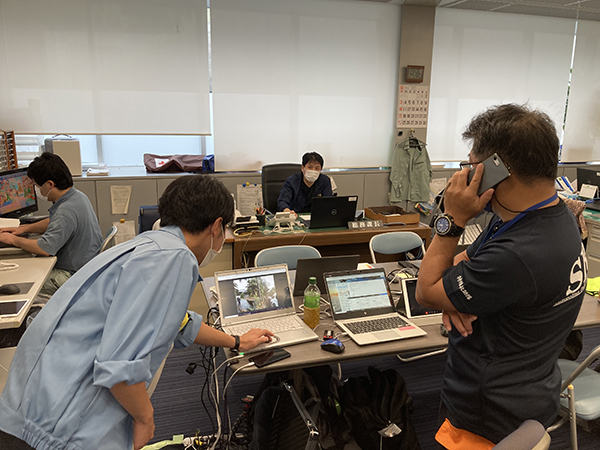
Support staffers collection and providing information at town’s disaster response headquarters
Digitizing Processes to Support Three Rail Projects in Manila
In recent years, the use of digital processes has become a focus not just for
engineering and construction supervision but also for maintenance, disaster
prevention, training, user services, and all sorts of other processes in overseas
infrastructure development projects. Manila, the capital of the Philippines, suffers
grave traffic congestion. Three yen loan-financed projects are underway there. They
are to build the nation’s first subway, the North-South Commuter Railway project,
and the Malolos-Clark Railway project.
A Japan International Cooperation Agency project supported an effort to establish
the Philippine Railway Institute and build personnel capacity. Oriental Consultants
Global has taken part in these projects as a joint venture head.
For this work, the company is exploring the advanced use of building information
modeling data through virtual reality while creating new services by digitizing
processes. For railroad construction projects, it generated building information
modeling data related to station buildings and facilities. It looks to use this data
in technical cooperation projects. It also aims to apply virtual reality in staff
training and operations and management after project completions. Oriental
Consultants Global will keep working closely with the Department of Transportation
of the Philippines to adopt digital processes in a range of settings.
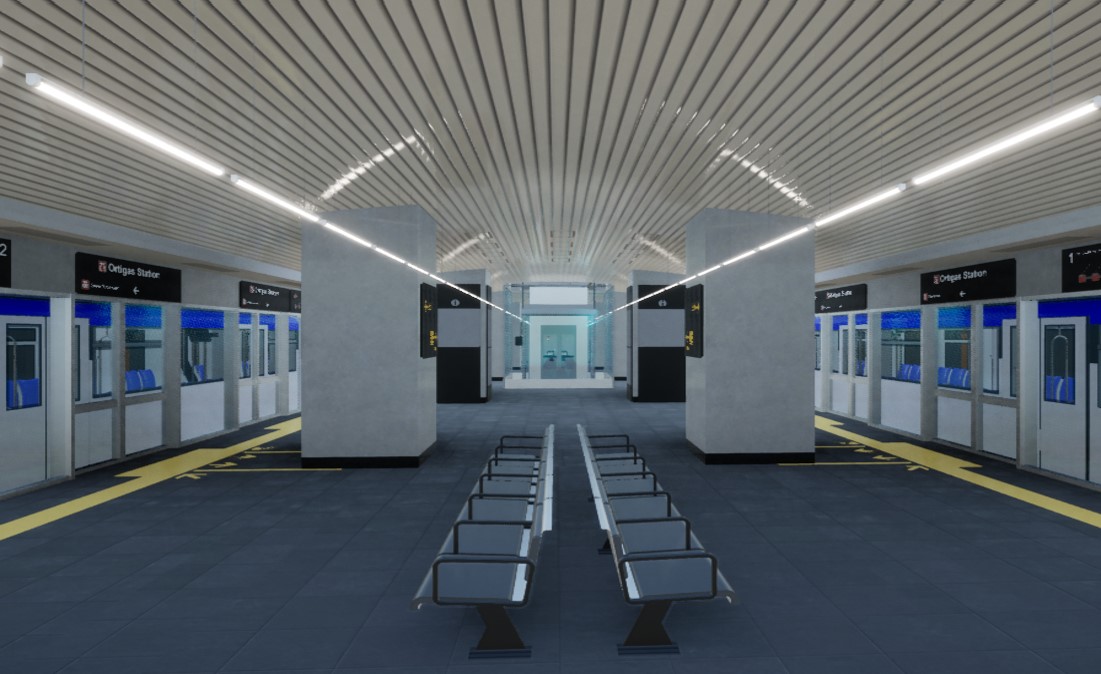
Virtual reality image of Metro Manila subway station
Using Technology that Projects Virtual Reality Imaging in the Real World
Asano Taiseikiso Engineering Co., Ltd., assists with station building inspections.
Just one of these checks can spotlight hundreds of defective areas. Routine on-site
assessments must take place within six months. It is tough for facilities managers,
whose teams are often small, to identify all problematic spots. Asano Taiseikiso
Engineering thus employs mixed reality technology in station building inspections,
and is developing technology to streamline checks.
Mixed reality combines augmented and virtual reality to create new spaces that merge
real-world and computer-generated environments.
Users can wear head-mounted displays or virtual reality headsets to inspect
stations. They see defective areas displaying on a station building so they can
efficiently check problem locations across sites.
Asano Taiseikiso Engineering is proposing its setup to railroad companies. It looks
to develop a station building inspection service that includes this system. It is
also pushing ahead with development with a view to employing the system in other
fields.
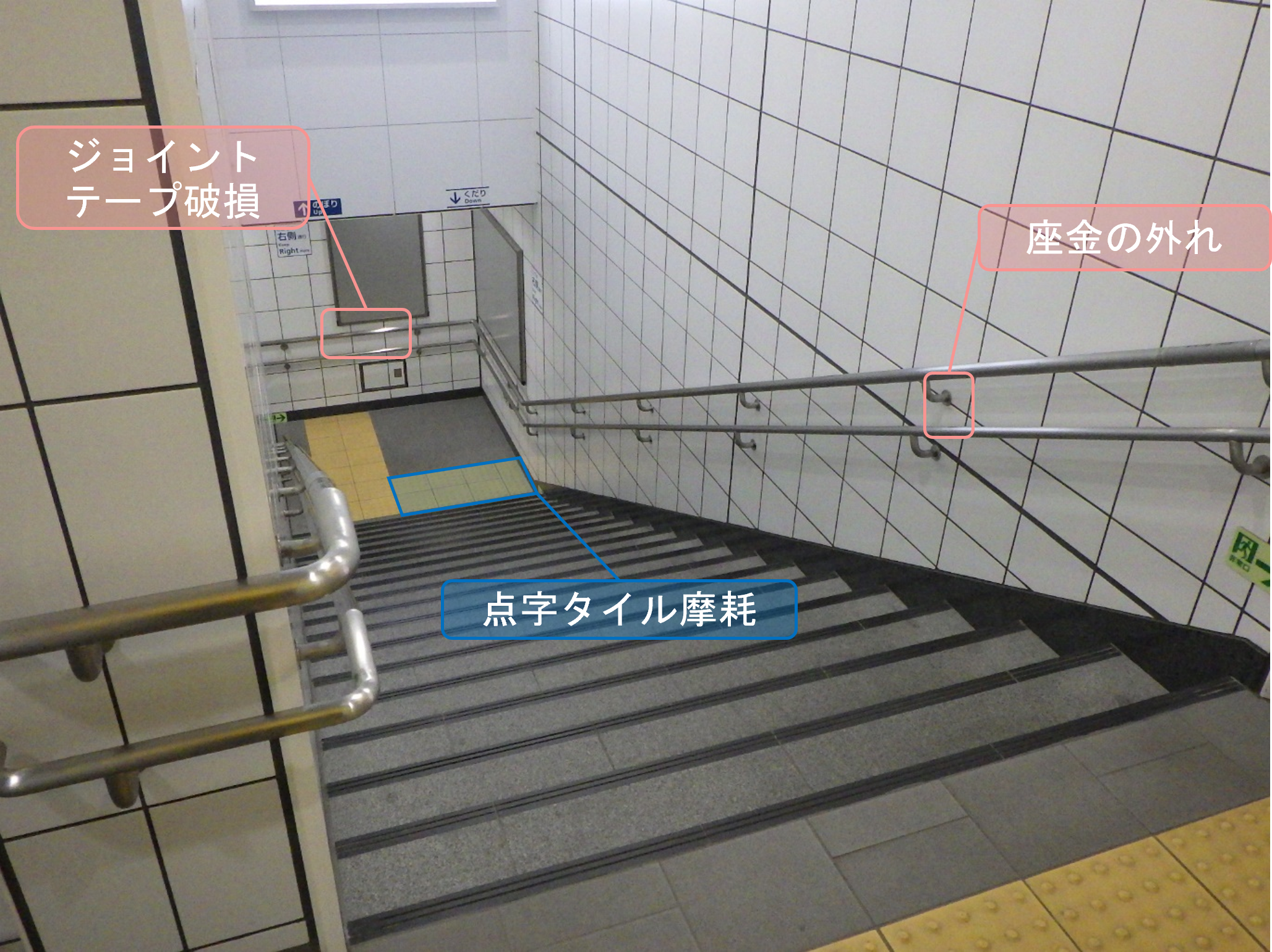
Display when the device is attached
Supporting Efficient Collaboration among Business Entities, Consulting Firms, Constructors, and Maintenance Management Companies
Outsourcing in the water supply and sewerage businesses is usually by stage.
Declining staff levels, more efficient business operations, and lower costs should
make complete outsourcing to joint ventures the norm in coming years. When
participating in joint ventures, Chuo Sekkei Engineering Company Limited fosters the
development of products that enable it to take the initiative with projects. A good
example is its development of a water supply and sewage facility management
system.
This system provides a digital transformation platform for collaboration between
ordering entities, consultant firms, constructors, and maintenance management
companies. Its functions include the ability to check facilities and equipment
specifications, installed locations, and related documents based on drawings. The
system can also assist with facilities risk assessments to explore ways to smooth
out renovation expenses. For field inspections, the system makes it possible to
import survey sheets into smartphones or tablets. The system can reflect survey
findings.
Chuo Sekkei Engineering has formed alliances with water and sewerage facilities
maintenance and management companies in pushing ahead with its business. It will
keep marketing its system to management company’s customers and will seek
comprehensive outsourcing orders.
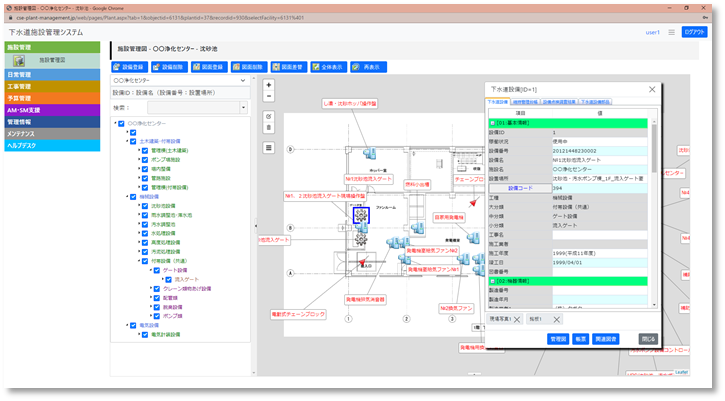
The system can display facilities and equipment documents
Assessing Measures to Increase Shared Taxi Riderships in Arao, Kumamoto Prefecture
Although it abounds in tourist attractions, the city of Arao in Kumamoto Prefecture
has suffered from low tourism traffic because of its varying offerings and location.
It therefore launched a ride-sharing taxi service in October 2020 for its public
transportation infrastructure.
Rider numbers remained low, however, and the prime users of the service was often
local residents. The city government looked into developing an app to attract people
of all ages to help resolve these issues. Group company Research and Solution Co.,
Ltd., helped develop an app combining tourism and transportation features.
It developed a proprietary mobility as a service platform using an information
distribution app creating service to enable reservations for the ride-sharing taxi
service. When users make reservations, they can augment regular route searches by
choosing sightseeing spots based on information registered in the platform.
Research and Solution added a feature that allows city officials to disseminate
various tourism information through the app. It is thus possible to register
excursion courses, issue coupons, and set up stamp rallies. By expanding installed
base, the city can attract new target users and encourage people to use its
ride-sharing taxis.
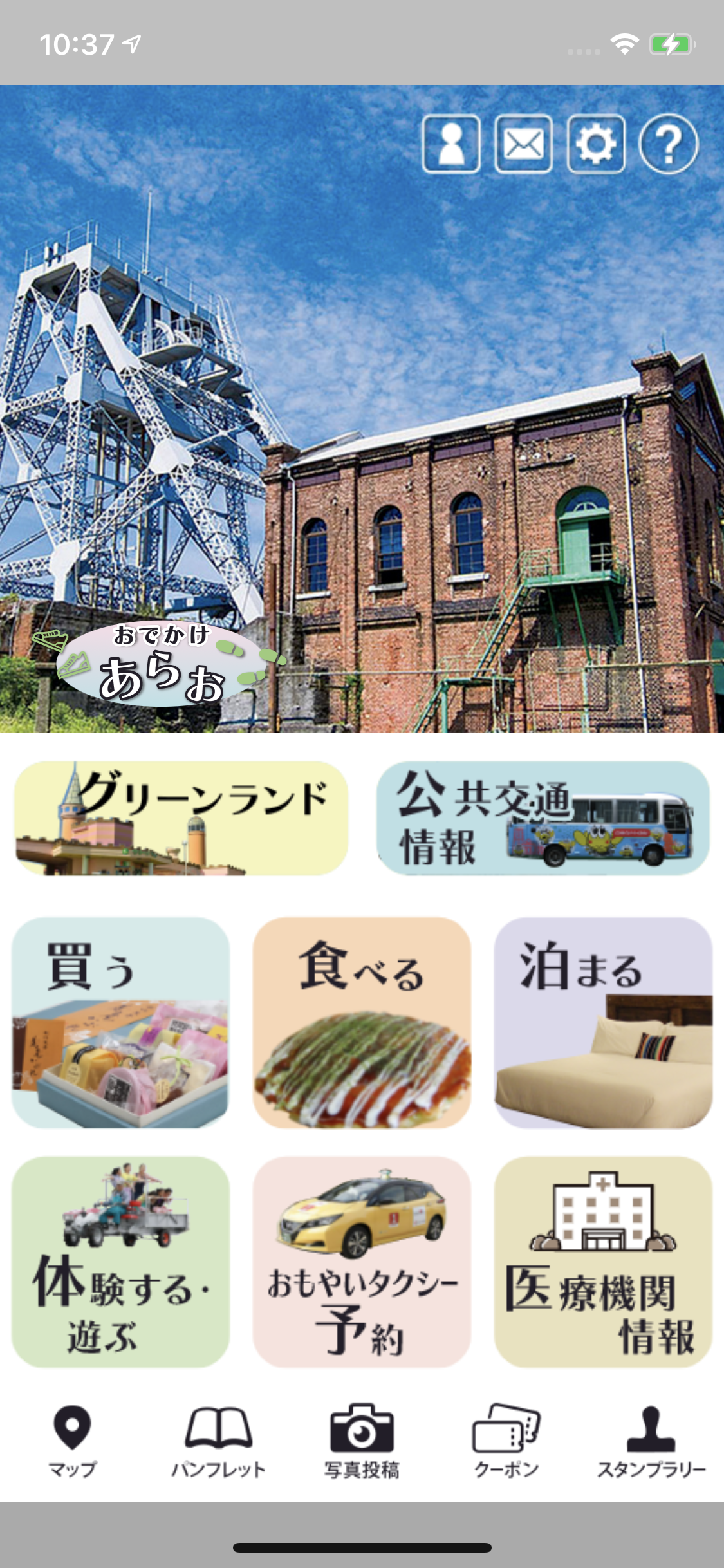
App landing page
Building and Developing 3D Design Support System to Streamline Operations
In principle, the Ministry of Land, Infrastructure, Transport and Tourism will apply
construction information modeling/management (CIM) data to all projects under its
direct control by 2025 to streamline construction site work. A-TEC Co. Ltd. began
preparing for that transition in 2019 by establishing a CIM team. It comprises 15
young through veteran members. The team handles various construction and building
information modeling (BIM) and CIM-related tasks. One of these is for a common
electric cable duct private finance initiative.
The design for a joint conduit is made to accommodate electric cables and water
pipes under roads, avoiding existing buried infrastructure across three dimensions.
It became challenging to identify the full picture when working with 2D drawings. It
was only on generating 3D data that interference with buried infrastructures became
evident at various locations, causing repeated revisions. The CIM team is thus
drawing on 3D design support tools in exploring ways to create a 3D data framework
from the outset. That is because creating interference-free 3D data and
incorporating it in blueprints eliminates the need for design revisions. Team
members are acquiring technology to convert 2D drawings into CIM data. It will
continue to build and develop a 3D design support system in a drive to enhance
efficiency.
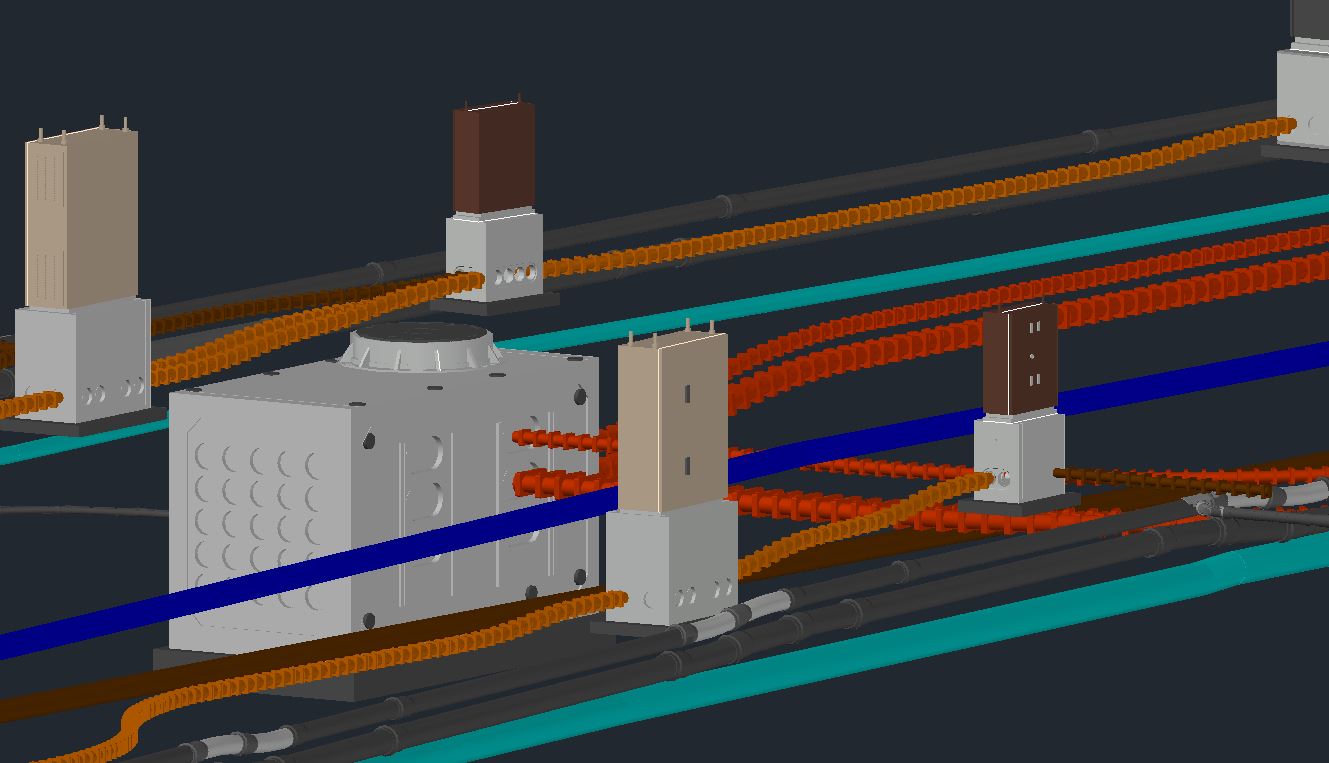
Conceptual drawing of final BIM/CIM models
[Philippines]
Bolstering Infrastructure by Completely Renovating Railroads
Manila has a population of more than 13 million. The capital is also an economic
hub, accounting for 40% of the nation’s gross domestic product. A poor public
transportation infrastructure has caused great traffic congestion, necessitating
urgent solutions.
One of three elevated railroad lines in Metropolitan Manila is Metro Rail Transit
Line 3. It operated stably under a Japanese maintenance firm company after its
inauguration in 2000. By 2012, however, system availability had noticeably degraded.
This stemmed from rolling stock and railroad system aging, spare parts procurement
delays, and insufficient maintenance.
This situation led to the May 2019 launch of a yen loan-funded rehabilitation and
maintenance project. Oriental Consultants Global took charge of construction
supervision. The project entailed overhauling 72 railcars and renovating existing
infrastructure, including by replacing equipment and lines.
The rehabilitation work ended in December 2021, after which maintenance began. The
rehabilitation efforts doubled maximum operating speeds to 60 kilometers an hour and
doubled frequency to one train every four and a half minutes while upholding safety
levels.
President Rodrigo Duterte and other dignitaries attended a completion ceremony in
March 2022. The renovation has boosted passenger capacity to around 600,000 people
daily, or roughly double the level before the project began. This should help ease
traffic in Manila.
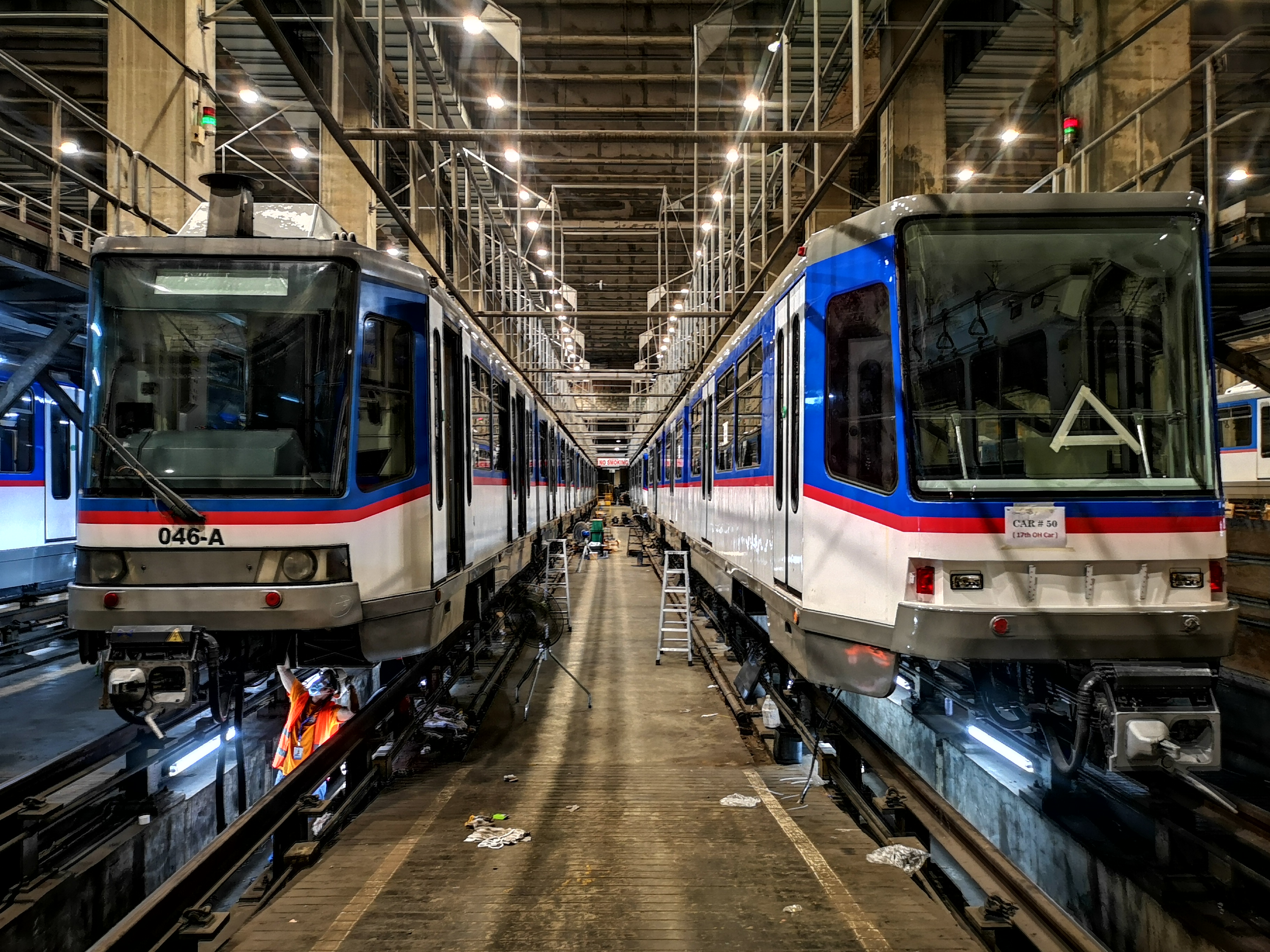
Rolling stock after overhaul
[Peru]
Helping Develop Local Industries to Improve Livelihoods and Protect Forests by Using
Sacha Inchi Pulp
Developing countries continue to suffer from deforestation resulting from improper
slash-and-burn agriculture and illicit subsistence logging. Many such nations are
thus acting to ensure the sustainable use of forest resources and secure livelihoods
for local people. It is hard for these nations to go it alone in undertaking such
initiatives, as their technologies and expertise are often lacking. In contrast,
Japan has amassed knowledge in these areas through a long-standing culture of living
in harmony with forests. Oriental Consultants Global is engaging in a range of
projects that tap Japanese techniques to foster sustainable forest management in
developing nations.
Sacha inchi, a plant from the Peruvian Amazon, requires short cultivation before
harvesting. It offers quick incomes and long-term storage. Its nut incorporates
high-quality fat and protein. Oil made from it has garnered worldwide attention for
health benefits. This is thus a vital resource for a region that suffers greatly
from poverty.
While a pulp by-product of the oil was distributed in some areas, it has been
underutilized. Recognition has remained low. Oriental Consultants Global responded
to this situation by using Japanese powder processing technology to improve the
pulp’s texture by making the particles finer and by using such traditional
seasonings as miso in developing products that suit Japanese palates.
By adding more value to this pulp and expanding uptake among Japanese consumers,
Oriental Consultants Global is helping enhance livelihoods in Peru residents while
contributing to efforts to prevent illegal logging and other illicit activities
while promoting conservation and proper forest usage.

Making sacha inchi pulp available to consumers in Japan will help improve livelihoods in Peru
Using Simulations to Identify Risks
The Atsugi municipal government commissioned Oriental Consultants to undertake a
study into alleviating congestion on arterial roads and make public transportation
more convenient. As it progressed, the study concluded that the north side of Hon
Atsugi Station in the city center needed to improve for users. This was because of
issues with accessibility to public transportation and connections to and from rail
lines and with movements in the area.
Oriental Consultants therefore embarked on a comprehensive effort to alleviate
congestion on main roads and resolve a range of traffic issues. It began by
producing a three-dimensional virtual reality model of the north side of Hon Atsugi
Station, drawing on data on people and vehicle flows from stationary cameras.
Oriental Consultants then made it possible to use virtual reality to simulate the
traffic impacts of the city’s plans. This trial revealed conditions from vehicle and
pedestrian perspectives and made it possible to identify prospective issues.
Oriental Consultants will look into ways to deploy and manage the data.
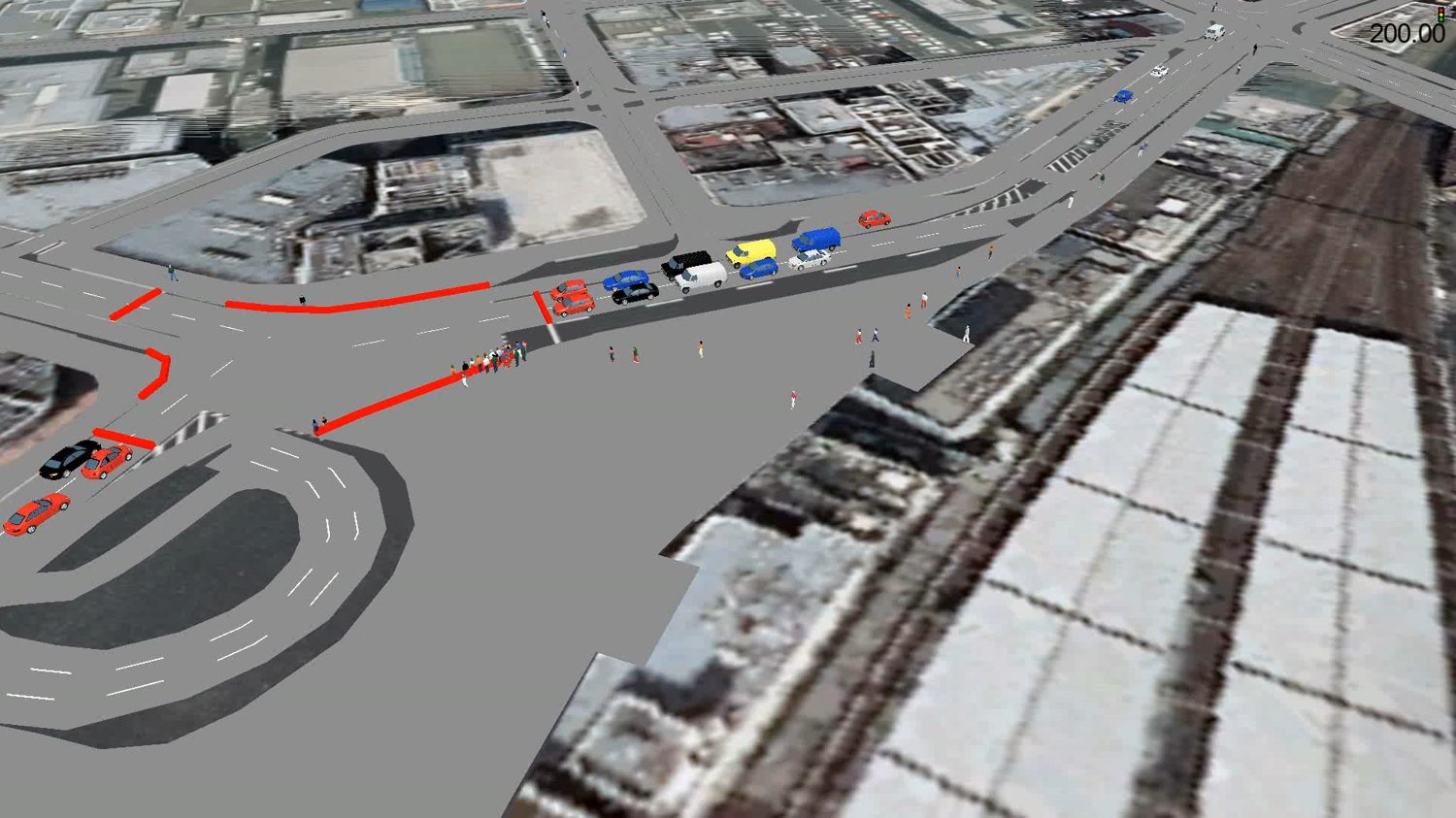
Simulation based on big data and results visualization
Surveying Walkable Community Development
In July 2021, Oriental Consultants and Intelligence Design Inc. conducted an experiment in Sannomiya, Kobe, to monitor road usage with the IDEA counter edge-AI camera.
The Ministry of Land, Infrastructure, Transport and Tourism aims to cultivate people-centered walkable urban areas. It is thus necessary to assess areas through which people and vehicles pass. Oriental Consultants and Intelligence Design conducted their surveys efficiently and accurately by initiating a project using edge AI cameras for automatic measurements.
They measured the numbers and locations of vehicles parked on streets and the parking durations. They also evaluated pedestrian traffic by attributes, stay times, and changes by time of day, and undertook an online evaluation of bustling conditions in streets space and parking demand for parking.
They will draw on experiment findings to enhance automated benchmark measurements and digitize urban development processes.
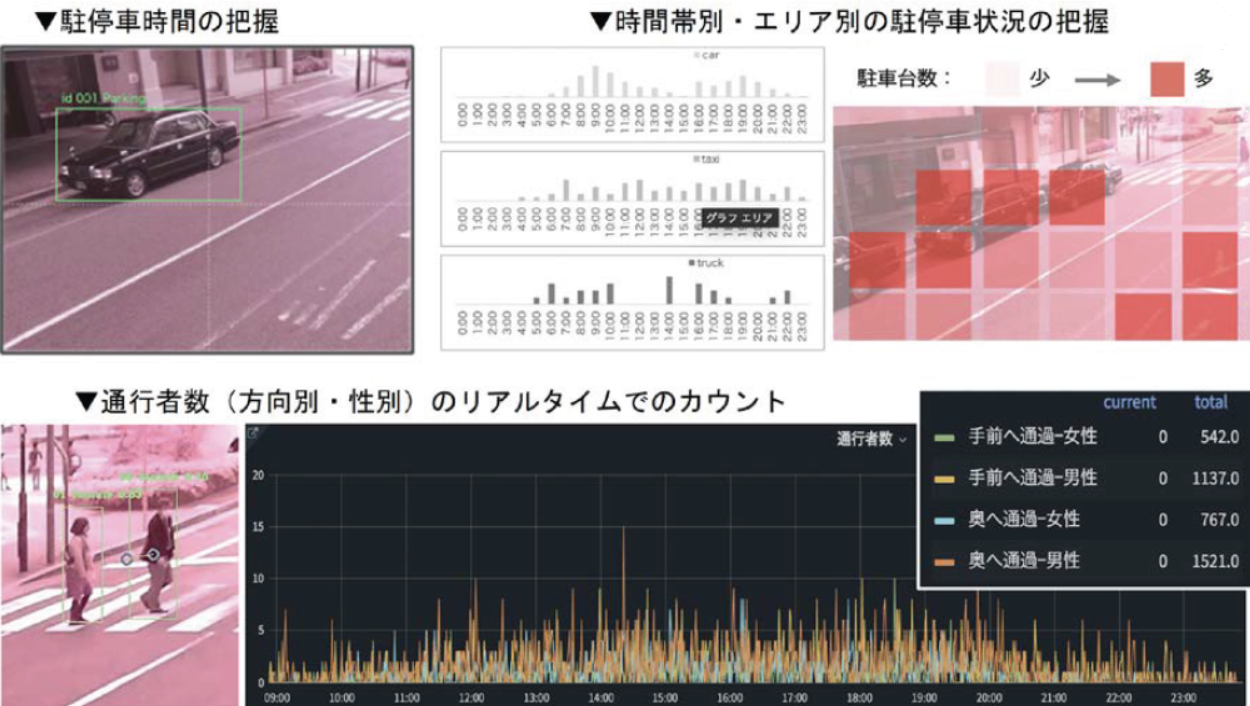
Observation with edge AI camera
Leveraging Position as Secretariat Head to Bridge Gaps between Local Governments and Private Sector
In July 2021, VISON opened in Taki, Mie Prefecture, as Japan’s first private facility connected directly to an expressway interchange. This new facility initiated efforts to promote the Mie Wide-Area Cooperation Super City Concept with Taki and five other municipalities. The goal is to resolve regional issues with advanced technology. Oriental Consultants has been involved with VISON since 2014. It serves as the secretariat for studying the VISON concept.
The aim is to deliver services seamlessly through digitization and ICT and resolve regional issues. All services, including public administration, public transportation, and medical care, could eventually link to a common ID, with people receiving services without preparing any documents. Oriental Consultants also looks to create an on-demand medical mobility as a service setup, and has experimented to validate it. A vehicle equipped with communication and medical equipment visited near patient homes and verified an online medical care mechanism.
Oriental Consultants will keep engaging in projects that resolve regional issues through public-private partnerships.

VISON, Japan’s first facility linked directly to an interchange
Ministry of Land, Infrastructure, Transport and Tourism's Open Data for Transportation City Planning
The Road Bureau of the Ministry of Land, Infrastructure, Transport and Tourism undertook a public-private partnership project to develop public transportation terminals that centrally connect rail, bus, and taxi, and other modes of transport. The goal is to deploy develop transportation nodes at 100 locations throughout Japan.
Projects to develop transportation nodes necessitate ensuring that facilities are sufficient to ensure the right traffic, disaster prevention, and bustle levels. It is also important to consider from various perspectives how best to configure functions and vehicle flows along surrounding roads.
The base for such planning and assessments is Plateau. This is an open data 3D city model from the Ministry of Land, Infrastructure, Transport and Tourism. These efforts also draw on building information modeling (BIM)* and traffic flow simulations for people and vehicles. These elements are combined to create 3D data.
The data is used to build a consensus with stakeholders and progress with urban transportation planning.
*A building information model is a computerized 3D setup that streamlines construction processes.
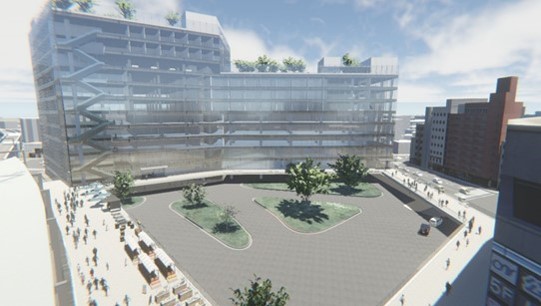
Drawing on BIM to construct a redeveloped station building and simulating pedestrian flows from there to the station plaza, bus stops, and surrounding buildings
[Mongolia]
Creating a Japanese-Designed and Operated International Airport
Oriental Consultants Global and Azusa Sekkei Co., Ltd., together oversaw the design and construction of the New Ulaanbaatar International Airport, which opened on July 4, 2021. Other Japanese companies also took part in construction and operations after the airport opened, making this a fully Japanese project.
The new facility came about because the location of its predecessor in Ulaanbaatar, Mongolia’s capital, was not ideal. It had been impossible to secure sufficient takeoffs and landings. The airport’s usability factor was thus very low.
The government therefore decided to construct a terminal area, including a new building that could handle 2 million passengers annually, as well as a 3,600-meter runway. It drew on yen loans for this initiative.
Considerable effort went into making the new airport as eco-friendly as possible. This included minimizing the amount of soil moved in and out of the site and designing the facilities to reduce energy consumption. Universal design touches include signage for visually and hearing impaired people and restrooms for wheelchair users. The terminal building enhances the experience for passengers by eliminating the need for them to move across levels.
In 2014 and 2015, two Oriental Consultants Global and Azusa Sekkei employees working on the project received commendations from Mongolia’s Minister of Transport. In 2018, they also received the Nairamdal (Friendship) Medal, one of the highest honors that the Mongolian government can bestow on foreign nationals, for helping enhance the nation’s relationship with Japan. In handing out medals, Mongolia’s Minister of Road and Transport Development said that he looked for the New Ulaanbaatar International Airport to contribute much to the country’s progress.
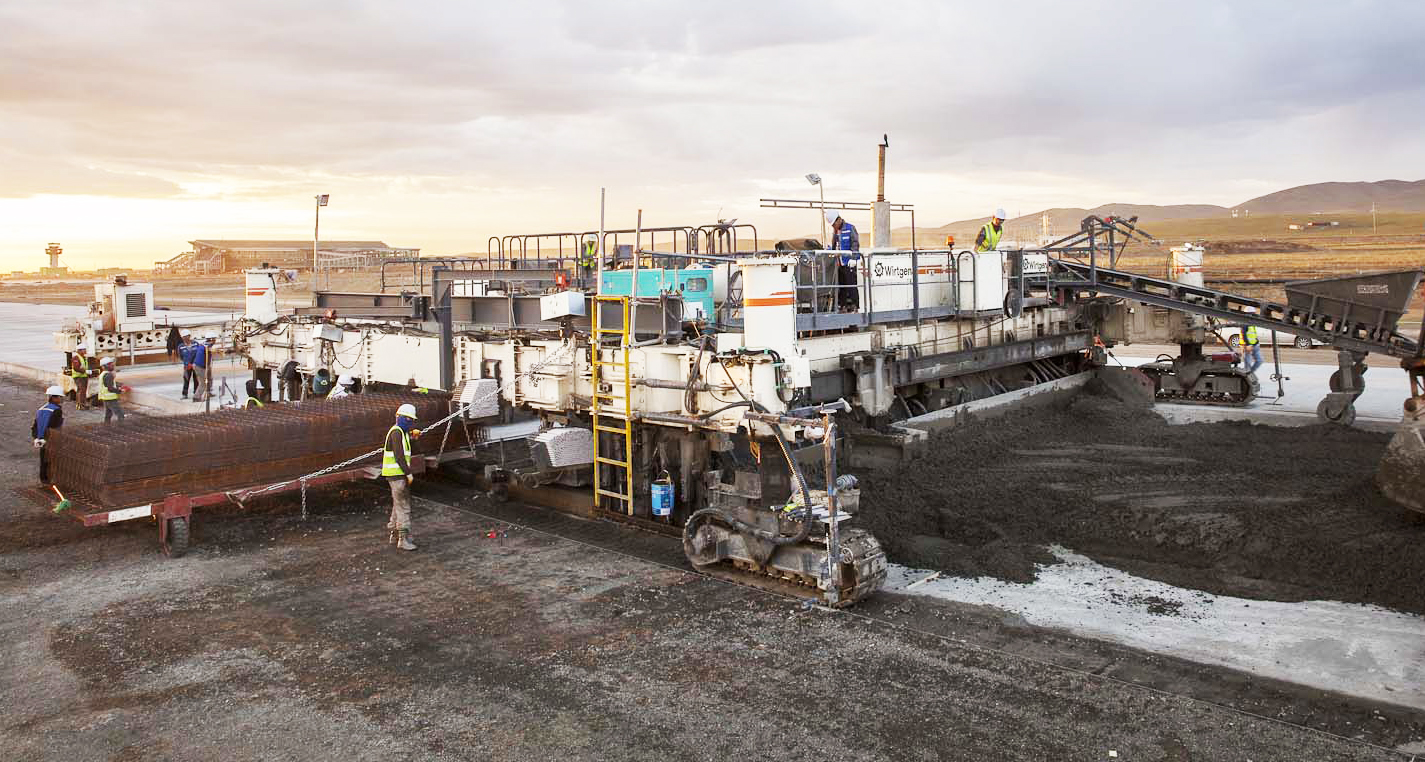
Large finisher capable of constructing two paved runway lanes at a time
[Sri Lanka]
Constructing a Six-Lane Bridge to Eliminate Traffic Bottlenecks
An underdeveloped railway system has forced Sri Lanka to depend heavily on road transportation. The Kelani River area is a key transportation hub connecting the Bandaranaike International Airport and the Port of Colombo with the city of Colombo. For years, access was primarily through bridges that had become bottlenecks. This situation prompted the government to secure yen loans to build the New Kelani Bridge and a road from it to the city center. This bridge features a Japanese extradosed design, which means that towers and diagonal members support the main girders. It incorporates steel box girder composite slabs. This technology originated in Japan. Some piers and girders employ high-performance bridge steel. The opening ceremony for the new structure took place on November 24, 2021, with high hopes for the role it should play in stabilizing economic growth.
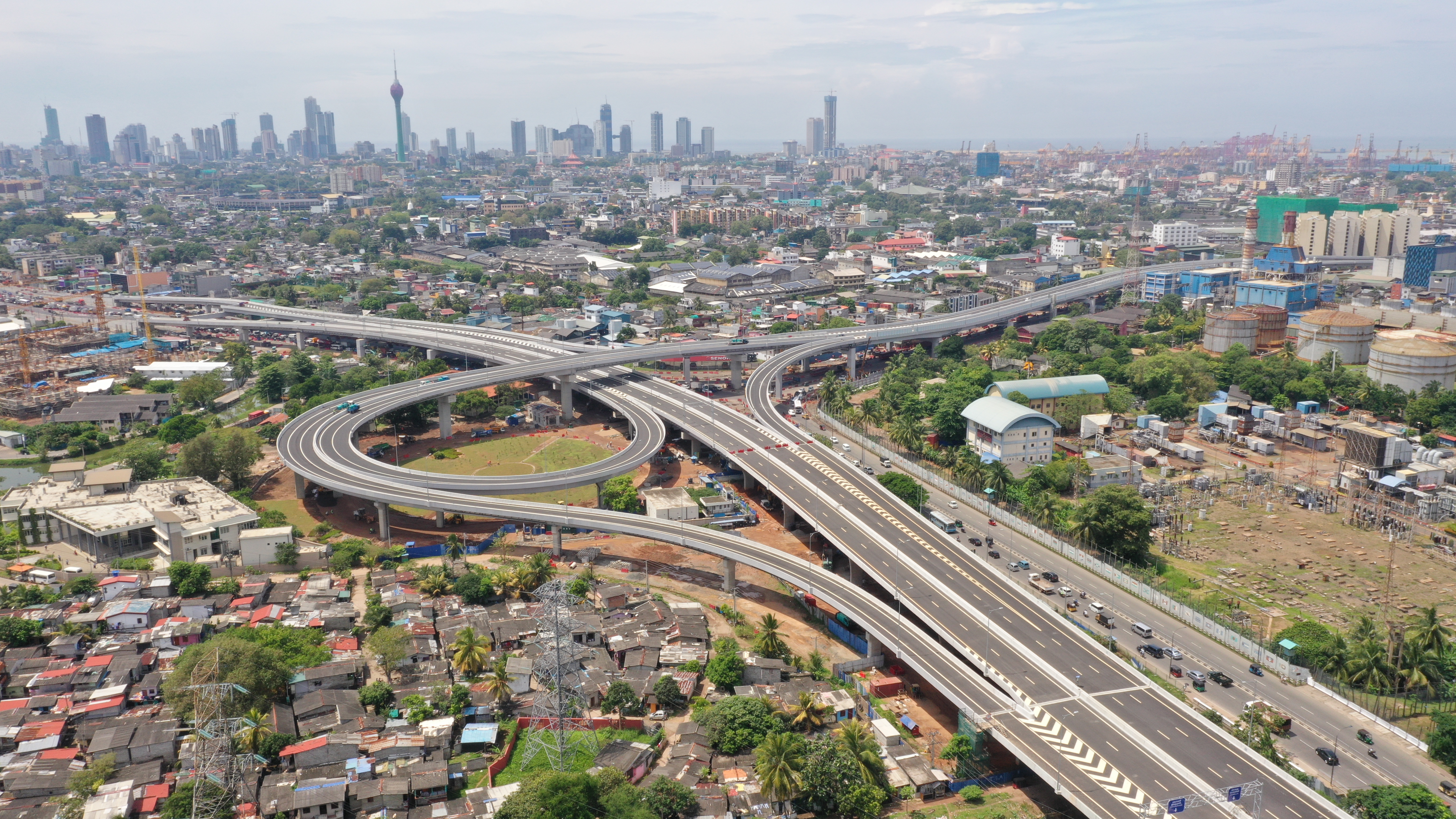
Panoramic view of junction
[Egypt]
Installing Solar Power Facility at University Campus to Help Cut Greenhouse Gas Emissions
Japan maintains a grant aid program to encourage initiatives to cut greenhouse gas emissions while pursuing economic growth. Such aid went to help install a solar power facility at the Egypt-Japan University of Science and Technology.
Oriental Consultants Global was in charge of the surveys, design, and construction for this project. The power system and structure were integrated by building a trestle at the campus, placing solar panels on it. An atrium, plaza, and parking lot are beneath the panels. The handover was at the end of December 2021.
This university provides a Japanese-style engineering education. It looks to use this solar power facility as a learning tool for its students.
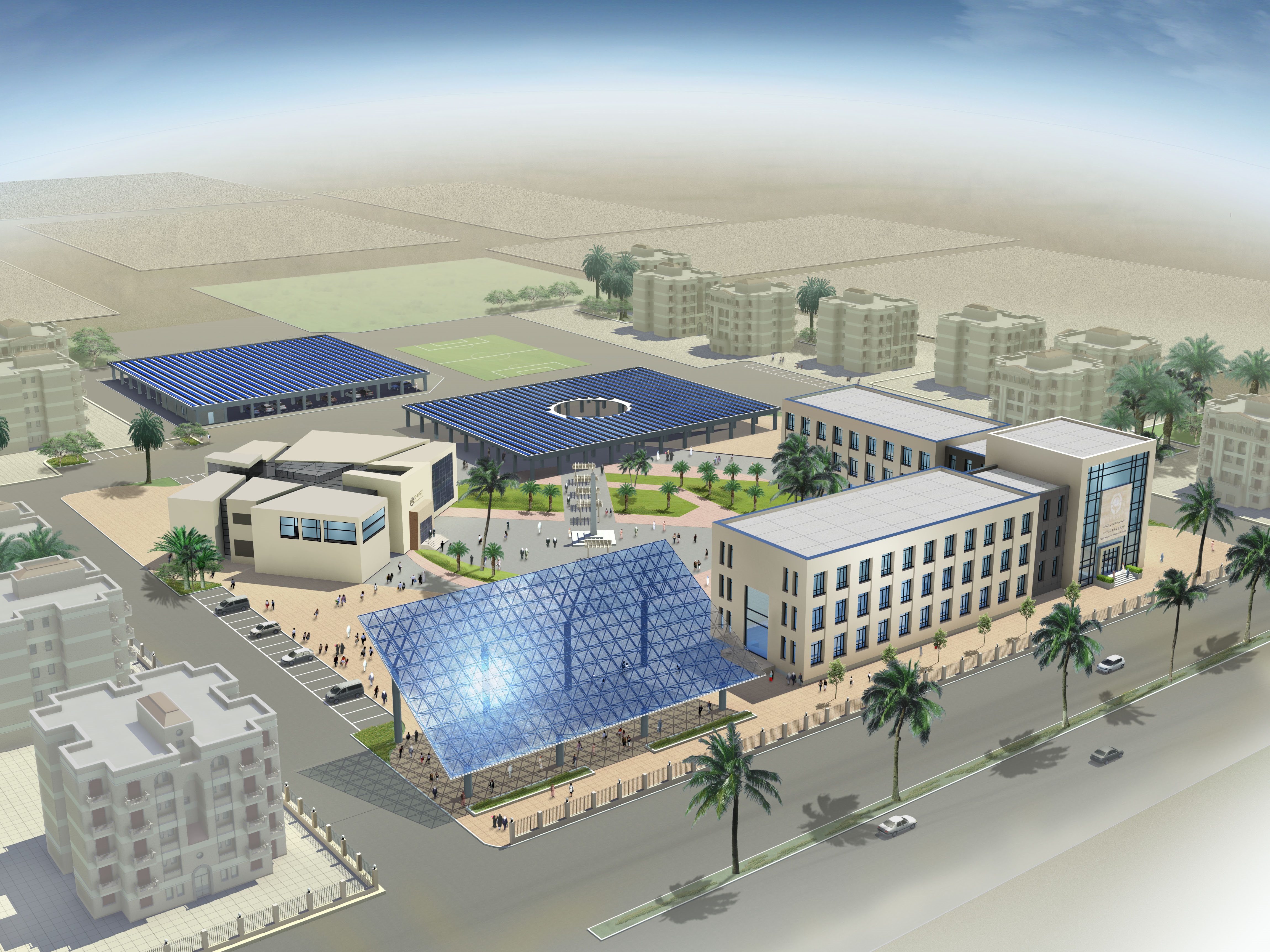
The solar panels are above girders in three locations, with atrium, plaza, and parking lot under them




